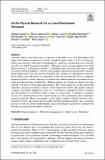Files in this item
On the physical nature of the so-called prominence tornadoes
Item metadata
| dc.contributor.author | Gunár, Stanislav | |
| dc.contributor.author | Labrosse, Nicolas | |
| dc.contributor.author | Luna, Manuel | |
| dc.contributor.author | Schmieder, Brigitte | |
| dc.contributor.author | Heinzel, Petr | |
| dc.contributor.author | Kucera, Therese A. | |
| dc.contributor.author | Levens, Peter J. | |
| dc.contributor.author | López Ariste, Arturo | |
| dc.contributor.author | Mackay, Duncan H. | |
| dc.contributor.author | Zapiór, Maciej | |
| dc.date.accessioned | 2023-05-26T12:30:04Z | |
| dc.date.available | 2023-05-26T12:30:04Z | |
| dc.date.issued | 2023-06-01 | |
| dc.identifier | 286648267 | |
| dc.identifier | 2a37b8ed-debf-4ee5-a662-e00b4e2729f0 | |
| dc.identifier | 85160090940 | |
| dc.identifier.citation | Gunár , S , Labrosse , N , Luna , M , Schmieder , B , Heinzel , P , Kucera , T A , Levens , P J , López Ariste , A , Mackay , D H & Zapiór , M 2023 , ' On the physical nature of the so-called prominence tornadoes ' , Space Science Reviews , vol. 219 , no. 4 , 33 . https://doi.org/10.1007/s11214-023-00976-w | en |
| dc.identifier.issn | 0038-6308 | |
| dc.identifier.other | Jisc: 1102169 | |
| dc.identifier.other | publisher-id: s11214-023-00976-w | |
| dc.identifier.other | manuscript: 976 | |
| dc.identifier.uri | https://hdl.handle.net/10023/27684 | |
| dc.description | Funding: Open access publishing supported by the National Technical Library in Prague. S. Gunár and P. Heinzel acknowledge the support from grant 22-34841S of the Czech Science Foundation (GAČR). S. Gunár, P. Heinzel, and M. Zapiór acknowledge the support from the project RVO:67985815 of the Astronomical Institute of the Czech Academy of Sciences. N. Labrosse acknowledges support from STFC grant ST/T000422/1. M. Luna acknowledges support through the Ramón y Cajal fellowship RYC2018-026129-I from the Spanish Ministry of Science and Innovation, the Spanish National Research Agency (Agencia Estatal de Investigación), the European Social Fund through Operational Program FSE 2014 of Employment, Education and Training and the Universitat de les Illes Balears. This publication is part of the R + D + i project PID2020-112791GB-I00, financed by MCIN/AEI/10.13039/501100011033. T. Kucera acknowledges support of the NASA Heliophysics ISFM program. D.H.M. would like to thank the STFC for support via consolidated grant ST/W001195/1. | en |
| dc.description.abstract | The term ‘tornado’ has been used in recent years to describe several solar phenomena, from large-scale eruptive prominences to small-scale photospheric vortices. It has also been applied to the generally stable quiescent prominences, sparking a renewed interest in what historically was called ‘prominence tornadoes’. This paper carries out an in-depth review of the physical nature of ‘prominence tornadoes’, where their name subconsciously makes us think of violent rotational dynamics. However, after careful consideration and analysis of the published observational data and theoretical models, we conclude that ‘prominence tornadoes’ do not differ in any substantial way from other stable solar prominences. There is simply no unequivocal observational evidence of sustained and coherent rotational movements in quiescent prominences that would justify a distinct category of prominences sharing the name with the well-known atmospheric phenomenon. The visual impression of the column-like silhouettes, the perceived helical motions, or the suggestive Doppler-shift patterns all have a simpler, more likely explanation. They are a consequence of projection effects combined with the presence of oscillations and/or counter-streaming flows. ‘Prominence tornadoes’ are thus just manifestations of the complex nature of solar prominences when observed in specific projections. These coincidental viewing angles, together with the presence of fine-structure dynamics and simple yet profoundly distorting projection effects, may sometimes play havoc with our intuitive understanding of perceived shapes and motions, leading to the incorrect analogy with atmospheric tornadoes. | |
| dc.format.extent | 40 | |
| dc.format.extent | 4135115 | |
| dc.language.iso | eng | |
| dc.relation.ispartof | Space Science Reviews | en |
| dc.subject | Observational diagnostics | en |
| dc.subject | Spectroscopy | en |
| dc.subject | Solar prominences | en |
| dc.subject | Modelling | en |
| dc.subject | QB Astronomy | en |
| dc.subject | MCC | en |
| dc.subject.lcc | QB | en |
| dc.title | On the physical nature of the so-called prominence tornadoes | en |
| dc.type | Journal item | en |
| dc.contributor.sponsor | Science & Technology Facilities Council | en |
| dc.contributor.institution | University of St Andrews. Statistics | en |
| dc.contributor.institution | University of St Andrews. Applied Mathematics | en |
| dc.identifier.doi | https://doi.org/10.1007/s11214-023-00976-w | |
| dc.description.status | Peer reviewed | en |
| dc.identifier.grantnumber | ST/W001195/1 | en |
This item appears in the following Collection(s)
Items in the St Andrews Research Repository are protected by copyright, with all rights reserved, unless otherwise indicated.

